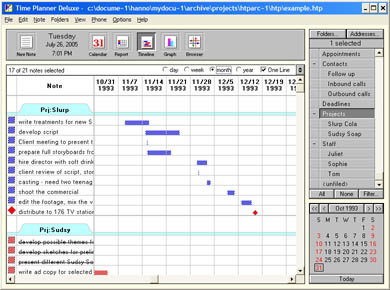Downloads for collectors of ancient software.
Originally for Windows 3.1 (1992)

In 1991, Apple was intolerably arrogant, IBM dazed and confused, and Linus still in college. Windows 3.0 came as a breath of fresh air; a good enough GUI for the rest of us that ran just fine on a computer we could afford. Charles Petzold wrote the indispensable one-volume explanation for developers; Borland introduced a very respectable C++ compiler. Windows 3.1, released in 1992, raised the ante. Every red-blooded programmer quit his day job and became an entrepreneur.
Personal Information Managers had a short run as a hot category around this time. Time Planner Deluxe was my entry, a hybrid between a lightweight project management system and a personal calendar. It offered the usual calendar functions plus integrated drag-and-drop Gantt charts with time and rate calculations.
Jeff Goldberg and I wrote Time Planner Deluxe, releasing version 1.0 sometime in 1992. We got lucky: it was licensed and relabeled by SoftKey as "Key Project Manager" and also bundled with Microsoft Office in a huge government contract.
Looking at this with hindsight, I see a classic design mistake: we larded it up with way too many features and didn't pay enough attention to the core use case. For something that was meant to be "personal" it just didn't flow well enough. These days I use OneNote; I think that's in spirit what I was aiming for.
License: MIT [GitHub repo]

Originally for DOS 2.0 (1983)
This was written in the early days for the original IBM PC.
Looking back, I find it hard to believe I wrote this thing in 8086 assembler -- so much effort for such modest results. Not smart. Anyway, Telios implements full VT-100 emulation, Kermit, Z-modem, command files - all the features that an up-to-date comm package had to have back in 1983. It may even have been the first commercial implementation of Kermit.
Telios directly accesses the old PC's 8250 UART, 8259 PIC and works around several early 8088 microcode bugs. These chips disappeared from the hardware many years ago; Telios will run in contemporary DOS emulators that virtualize these chips.
License: MIT [GitHub repo]